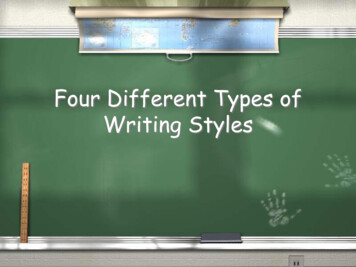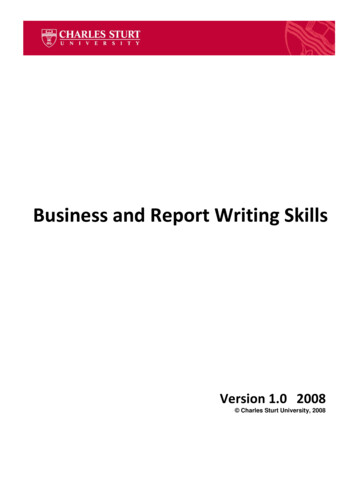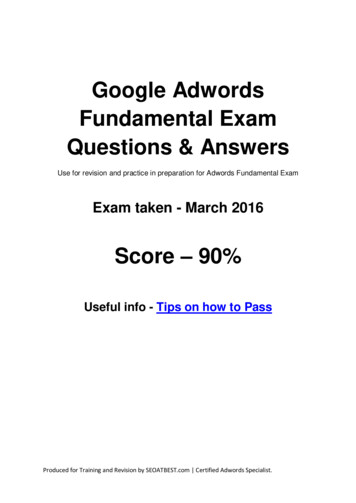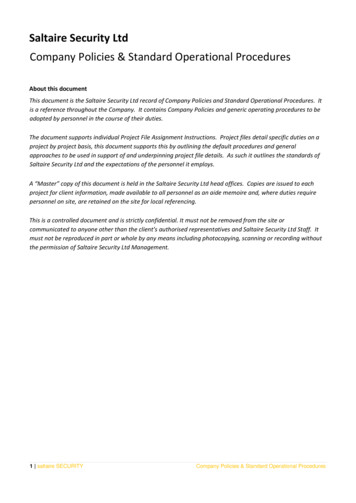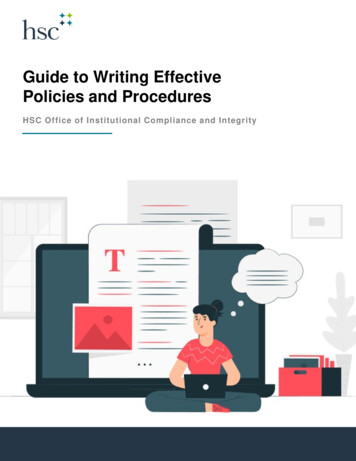
Transcription
Guide to Writing EffectivePolicies and ProceduresHSC Office of Institutional Compliance and Integrity1
IntroductionGuide to Writing and MaintainingPolicies & ProceduresPolicies and Procedures are intended to bepractical, administrative guides with both style andcontent determined by user needs. The only waythis can be the case is if each and every policyand procedure document is developed, written,and updated with the user in mind.This guide is designed to help policy owners andpolicy subject matter specialist (SMS) at UNTHealth Science Center with the process ofresearching, writing, and maintaining theirpolicies. It also explains the review and approvalprocess for campus wide administrative policies.This guide should be used as a resource byanyone who develops or updates campus wideadministrative policies for their department.2
Table of Contents01IntroductionPage 202The Importance of Policy EffectivenessPage 403How Policies & Procedures WorkPage 504Determine Need for Policy or ProcedurePage 605Modifying the Standard StructurePage 806Policy & Procedure DevelopmentPage 907Review & Implementation ProcessPage 1008Policy TemplatePage 123
The Importance of PolicyEffectivenessA crucial element of an effective compliance program is thatemployer’s clearly state the prohibition of conduct that violates the3 P’s- policies, procedures and processes. Robust policies andprocedures are imperative, but almost worthless if they are notread and effectively understood. Policies and procedures must becomprehensively and effectively communicated.Effective policy management enables compliance and ethicalbusiness. This ensures good governance, best practices andcompliance.5
How Policies &Procedures WorkIt’s important to note that Policies and Procedures are not the same thingPoliciesPolicies serve as a functional framework for HSC, which states theintentions to guide decision-making. Policies and procedures must bewritten so that people can get the information they need in order todo the job they are assigned to do. Policies without procedures resultin inconsistent practices.ProceduresProcedures are a combination of one or more business processesand are outlined steps to take, and the order in which they need to betaken. Well-written procedures are typically precise, factual, short andto the point. It provides a series of routine steps to accomplish anaction.BenefitsPolicy BenefitsProcedure BenefitsDefined boundariesReduced learning curve/trainingtimeEliminates “Trial and Error”approachConsistent and Effective OutcomeProvides guidance on how tohandle issues properlyStandardized processes6
Is a Policy or ProcedureNecessary?Here’s How to Erase UncertaintyIt is wasted effort to write a policy or procedure “just because”. Before you decidethat you need a policy or procedure, be sure you can express the problem youneed to solve and that a solution existsPolicies and procedures are usually needed for personnel, safety and healthissues, or when you need to control, inform, educate or direct.If considering a policy in response to an event, ask yourself: Has this happened before? What are the chances it might happen again? Do potential consequences involve financial or legal issues?Signs that and informal rule or unwritten rules is not workingExternalForcesInternalFactorsNew orupdated lawsChange ologyIncreasedwasteInnovationsInconsistency6
Modifying the Standard StructureIn general, it is best to stay close to the standard template. Thecloser you are to the standard template, the easier it will be forusers to find the information they need. However, there may beoccasions where you may need to add different parts/headings tothe policy to increase ease of use.Whenever you add a part/heading to the policy, it should besomething that identifies a significant aspect of the policy. Anyheadings should be descriptive of the information to follow. All ofyour part headings should be of equal importance.No matter how many headings you determine you need to clearlycommunicate your policy, you should retain the outline structurefor all documents developed in PolicyTech.7
Policy & ProcedureDevelopmentPolicies need to be concise, consistent and easy to read. Using clear andsimple language increases the probability that the policy will be understood andfollowed. Use short, everyday words when possible. Simple words are easierand faster to read for all levels of readers, and will aid in understanding. Keepsentences brief. Longer sentences demand greater concentration from thereader and may make the meaning difficult to follow.Effective polices are easy to read. “Plain language” is a writing style that helpsreaders: Find what they need, Understand what they find; and Use what they find to meet their needs.Follow the guidelines below for plain language writing:Write in the “active voice”. In an active-voice sentence, the person ordepartment taking the action is the subject of the sentence. Passive-voicesentences often do not identify who is performing the action:Passive VoiceThe Lake was polluted by the companyNew regulations were proposed.The following information must be includedin the application for it to be considercompleteActive VoiceThe company polluted the lakeWe proposed new regulationsYou must include the following informationin your application.Choose words wisely. Use direct language like must, will and prohibited ratherthan should, should not, shall and may as these words may imply an action isnot mandatory.Wordy, dense documents are confusing to the reader. Edit your policy toreduce unnecessary or redundant information. This task can be difficult for thewriter him/herself or for a subject matter expert, so have a fellow colleague readyour document and provide feedbackBe consistent. Make sure that examples and clarifying statements do notconvey different meanings or interpretations. Double check that policy languagedoes not conflict with already existing policies and procedures and all yourinformation is factual and up-to-date.6
Review &Implementation ProcessWhen you have completed a draft of the policy, checked all of your facts, andconsulted with the appropriate individuals, follow the steps as established byyour department head. If your unit policy coordinator does not conduct thisreview; it is your responsibility to do so before submission to Policy r. With yourdraft, you also need to submit a list of individuals who have been consultedduring development.Establishing a Communication StrategyThe Pros and Cons of Notifying Users in Person, In Writing and by EmailWhether you should notify user in person, in writing or by email will depend onthe following: Length of Document Number of people being notified Material’s complexity Need for speedNotify in Writing If users are externalIf the content iscomplex or longIf the subject is notcontroversialIf face-to-facecontact is notimportantNotify in Person If the content iscontroversial orsensitiveIf there theaudience group issmallIf you want to givethe contentimportanceIf you need toexplain all or part ofthe policyNotify via Email If face-to-facecontact is notimportantIf subject is notcontroversial6
ResistanceGuidelines for Navigating ResistanceFor most people, change is hard and unwelcome. Fear of the unknown of beingtaken advantage of are common reactions. You will likely hear, “But we’vealways done it this way” or “This policy is really dumb.” No matter what you door how well you prepare, you will probably meet with resistance from someemployees.Five Trusted Guidelines1.2.3.4.5.Anticipate ObjectionListen effectivelyProvide background, facts and reasoningClarify what is saidEnforcement is crucialResponsibilities of Policy DevelopersThe primary responsibility of policy developers is to ensure the continuedaccuracy of the policies they have been assigned by their department. TheHSC Community relies on policies to provide accurate guidance and regularlymake important business decisions based on the information contained withinthe policies. Wherever a policy is updated, the policy developer is responsiblefor uploading the policy into Policy TechAll policies must be reviewed, revised and or updated at least every 2 years.The vast majority of policies do require some type of update even if only aminor update, within this time span. If, after reviewing the policy you determinethat it remains accurate exactly as published, extend the next review date listedin PolicyTech so that the policy reflects that it is still effective. By regularlyreviewing, updating, and reissuing polices as needed, you send a clearmessage to the HSC Community that they can rely on the accuracy of thepolicies owned by your department.6
Sample PolicySee Policy Tech for Policy & Procedure TemplateChapter XXPolicies of the University of North Texas HealthScience CenterName of Policy- policy owners must ensure the policy is(to be assigned by the Office of InstitutionalCompliance)named in a way that is intuitive, so that the intended reader knowsgenerally what the policy covers, and it is easy to find whensearching.Policy Statement.Give a brief description (one or two paragraphs) of the policy. This section should be asummary or overview, and should not include any substantive aspects of the policy.Application and Purpose of Policy.This section should lay out the intended goal of the policy, and why it this particular policy isnecessary at UNTHSC. It also should detail to whom the policy applies.Definitions.Include a glossary section to define terms that the average person might not know orunderstand in the context of the policy. If a glossary of terms exists outside of the policy,reference that glossary here with a hyperlink, if applicable.Policy and Responsibilities.The body of the policy itself. All substantive aspects of the policy should be explained, aswell as any exceptions to the policy (if applicable) and consequences for not following thepolicy.Reference.Include a reference to any applicable laws, regulations, or Regents Rules in this section.Likewise, if this policy is required for accreditation, this section should state that explicitly,including what the accrediting body requires to be included in the policy to meet theaccreditation criteria.Related Policies and Procedures:Any related policy and proceduresReviewed by Office of the General Counsel: Date and Name of AttorneyApproved: DateEffective: DateRevised: DateNext review due on or before: DateContact Information/Policy Owner: Name of Subject Matter Specialist (SMS) orDepartment Head
OFFICIAL INSTITUTIONAL PROCEDUREPROCEDURE NAME (R*)Title (avoid using procedure in the name)EFFECTIVE DATE (R*)Original date of implementation(adoption date)PROCEDURE NUMBER (R*)alpha-numeric format (e.g. ICO-1.01A)PROCEDURE STATEMENT (R*)An institutional procedure is strictly operational. Procedures contain a series of consecutive action steps related to a policy that specifies how aparticular policy should be carried out. Procedures may have detailed instructions, definitions, and/or forms that facilitate policy compliance.Generally procedures change more frequently than policy and have a separate approval process.REASON FOR PROCEDURE (O*)Background information explaining the need and purpose for the procedure. Reference external requirements (law, regulations) and university decisionsthat support why we have the procedure.AREAS OF RESPONSIBILITY (R*)Lists departments, units, offices, and individual job titles for those who have responsibility for aspects of daily control and coordination ofthe procedure, authority to approve exceptions to the procedure (if applicable), and procedural implementation (including responsibilityfor any required electronic or written forms). Sets forth the scope of such department’s, unit’s, office’s, or individual’s responsibilitiesunder the procedure, the procedural areas subject to discretionary modification (if any), and the responsibility for implementation.PROCEDURE DETAILS (R*)Using an approach which is customized to the subject (i.e., can be a statement in outline format of each step required, a checklist of whatneeds to be done, an explanation of how to complete the necessary forms or screens—including copies of the forms or screens, or anappropriate combination of techniques), provide the reader with the necessary procedural and “how to” information. Included in thissection should be definitions of unique terms or terms subject to different interpretation and copies of all forms needed to complete theprocedure. A transaction flow chart might also be included in this section.Office of Institutional Compliance and IntegrityMay, 2019
RELATED INFORMATION (O*)Links to associated policies, standards, guidelines, and regulations that support the procedure statement. Standards are mandatory controls andguidelines are non-mandatory recommendations or best practices that support the procedure.DEFINITIONS (O*)Include defined terms that have particular meaning or need for interpretation relative to the procedure or provide links to a central glossary.FORMS/ONLINE PROCESSES (O*)Include links to related forms or online processesHISTORY (R*)Revision Date(s): Include date last revised (this date should not be the same as the effective date) and previous revised dates.Reviewed Date(s): Include date of last review.ADMINISTRATIVE AUTHORITY (R*)Title of Highest Level Department AuthorityRESPONSIBLE UNIVERSITY DEPARTMENT/DIVISION (R*)Title of Administrative Oversight Department/Office/ProgramAddress, City, StateGeneral Telephone NumberGeneral Email*R Required*O OptionalOffice of Institutional Compliance and IntegrityMay, 2019PolicyTech, the institutional policy repository, is updatedregularly. In order to ensure a printed copy of this documentis current, please access it onlineat cies/
This guide is designed to help policy owners and policy subject matter specialist (SMS) at UNT Health Science Center with the process of researching, writing, and maintaining their policies. It also explains the review and approval process for campus wide administrative policies. Th





